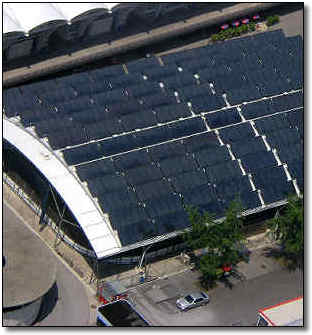
November 10, 2004
One of the most famous project examples of solar absorption technology, the Arnold Schwarzenegger Stadium in Graz, Austria. Schwarzenegger was instrumental in getting the solar HVAC system installed here.
Photo: New World Solar

|
November 10, 2004 One of the most famous project examples of solar absorption technology, the Arnold Schwarzenegger Stadium in Graz, Austria. Schwarzenegger was instrumental in getting the solar HVAC system installed here. Photo: New World Solar |
"Adding solar HVAC to the portfolio mix provides
new options for power-hungry industrial users."
- Commissioner Jeff Hatch-Miller
Three years ago, Arizona became one of the leading states in the nation to
support the use of renewable energy sources for electric power generation.
Beginning in 2002, their Environmental Portfolio Standard required regulated
utilities to generate a minimum percentage of their total retail energy sales
from renewable sources.
"Arizona has been on the leading edge in requiring the use of renewable
sources of energy," Commissioner Bill Mundell said. "This pilot
program is designed to encourage the installation and operation of five solar
HVAC systems as part of the Environmental Portfolio Standard. We need to
encourage these new technologies if we are going to wean ourselves off of fossil
fuels."
Unlike technologies that generate electricity, solar HVAC technology saves
energy that the customer would otherwise need to draw from the electrical grid.
Arizona's energy use spikes in the summer due to the intense demand for air
conditioning and the power necessary to run these systems. A solar HVAC system
would provide summertime cooling without straining the electrical grid. In other
seasons, energy captured by this technology can be used for space heating or to
heat water for various applications within a building.
"For example, a high school could have a solar HVAC system to provide air
conditioning in the warmest months," Commission Chairman Marc Spitzer
explained. "During the cooler months, the system could provide hot water
for dishwashing and cooking in the cafeteria or for showers in the gym."
Traditionally, solar thermal or solar hot water technologies are used only for
heating. Configuring the system for cooling and air-conditioning is the real
trick.
These solar HVAC systems operate using the process of "absorption
cooling." According to the U.S. Department of Energy, absorption cooling is
the first and oldest form of air conditioning and refrigeration. An absorption
air conditioner or refrigerator does not use an electric compressor to
mechanically pressurize the refrigerant. Instead, the absorption device uses a
heat source, such as natural gas or a large solar collector, to evaporate the
already-pressurized refrigerant from an absorbent/refrigerant mixture. This
takes place in a device called the vapor generator.
Although absorption coolers require electricity for pumping the refrigerant, the
power amount is small compared to what is consumed by a compressor in a
conventional electric air conditioner or refrigerator. When used with solar
thermal energy systems, absorption coolers must be adapted to operate at the
normal working temperatures for solar collectors, between 180 to 250 degrees F
(82 to 121 degrees C). It is even possible to produce ice with a solar powered
absorption device, which can be used for cooling or refrigeration.
Solar HVAC systems are in use in Israel, Japan, China and some European
countries according to Lori Glover, president of New World Solar, formerly So
Cool Energy. Glover attended the Commission meeting to speak in favor of
approving this technology. The Commission order does not specify the vendor or
specific design criteria. Glover's firm is one of several companies that could
supply a solar HVAC system under the program approved by the Commissioners.
Arizona would be the first state to acknowledge this emerging technology as a
qualifying project under a renewable energy portfolio, according to Glover.
"The kilowatt hours saved through the pilot program would be eligible to
meet the solar electric requirements of the Environmental Portfolio
Standard," Glover said.
Commissioner Mike Gleason said the kilowatt hours saved through the pilot
program would be eligible to meet the solar electric requirements of the
Environmental Portfolio Standard. Utilities or electric service providers
wishing to participate in the solar HVAC pilot program are required to file
notice with the Utilities Division that identifies the specific proposed
project.
"In February 2004, we unanimously voted to continue increasing the
percentage derived from renewable sources," Commissioner Jeff Hatch-Miller
said. "Adding solar HVAC to the portfolio mix provides new options for
power-hungry industrial users."
The Environmental Portfolio Standard covers solar technologies such as solar
generation, solar water heating and solar air conditioning. Non-solar
technologies such as landfill-gas generators, wind generators and biomass
generators are also qualifying technologies. Unlike many other states, Arizona's
definition of environmentally friendly, renewable technologies currently does
not include hydroelectric generation or geothermal power.
Please Note: RenewableEnergyAccess.com and Arizonaenergy.org do not endorse the sites behind these links. We offer them for your additional research. Following these links will open a new browser window.
Copyright © 1999 - 2004 - RenewableEnergyAccess.com
Please visit www.RenewableEnergyAccess.com for great coverage on energy today!!